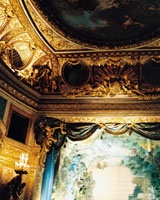 Marie Hennechart
Marie Antoinette's private theater, a miniature masterpiece of trompe-l'oeil, is once again a gilded pleasure
Marie Hennechart
Marie Antoinette's private theater, a miniature masterpiece of trompe-l'oeil, is once again a gilded pleasure
"You're in charge here now. Try to save my poor Versailles," Louis XVI is said to have told his war minister as the royal family fled its extravagant residence in the early days of the French Revolution. Versailles was indeed saved, though not for the hapless monarch. Of its countless restorations, the most recent is that of Marie Antoinette's private theater.
Built in 1778 and 1779, the Théâtre de la Reine served as a refuge for the queen from the pomp of the court; as such, it was intimate by Versailles standards, with seating for only 160. Its seemingly lavish ornamentation—marble inlay, gilded sculptures and garlands—was largely created using trompe-l'oeil painting and papier-mâché.
In 1997, the World Monuments Fund France recognized the need to stabilize the ceiling and balcony and sponsored the theater's $700,000 renovation. To bring the illusions back to life, it employed traditional masons, gilders, painters, and tapestry weavers—such as the Lyons textile firm, in business since the 18th century, that was hired to re-create the original blue linen-and-silk fabric adorning the walls.
Today, Versailles is the site of several preservation efforts: the Retours de Chasse dining room and the Antichambre des Chiens inside the château reopened last month; the 10,000 trees downed by a devastating storm in December 1999 are being replanted. Louis XVI and Marie Antoinette, alas, did not fare quite so well.